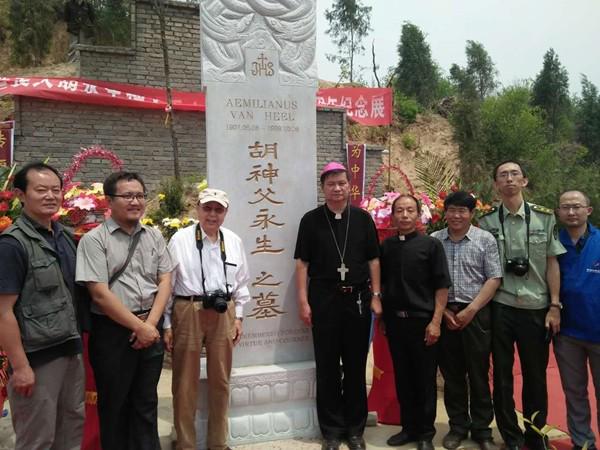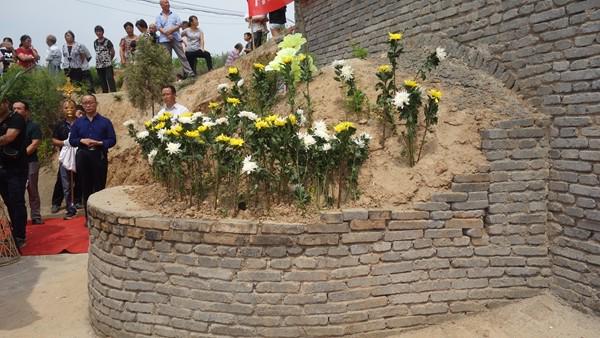A new stone marker for Father Aemilianus Van Heel was unveiled on June 17, 2017 together with its 110th Anniversary commemoration ceremony in Yuanqu, Shanxi Province. Gao Bin, son of the commander of No. 17 Army during the anti-Japanese war Gao Guizi, Jiang Yuchun, the person in charge of the Rabe Exchange Center in Beijing, and more were invited.
Father Aemilianus was born in Leiden, Holland on June 8, 1907. He came to China as a missionary in 1933 and was the father of the Catholic Church in Shitougeta Village (current Changzhi Village) in Yuanqu, Shanxi. He was deeply beloved by the villagers because he was always ready to give. He practiced medicine, took in orphans, and loved the local people. In 1938, the Japanese army invaded Yuanqu. They burned, killed, robbed, raped, and tormented many people. More than 2,000 women and children hid in the church seeking refuge. Father Aemilianus arranged for the refugees' accommodation while coping with the Japanese soldiers who kept picking trouble with the church. They even asked him to expel the women so that they could have their way with them. However, the Japanese were enraged when Father Aemilianus turned them down and rebuked their impudicity. Unfortunately, they brutally killed him on the night of October 8.
Father Aemilianus died when he was only 31 and his story was told all around southern Shanxi. The church affairs were taken over temporally by President Zheng Zhongyi.
Three years later, General Gao Guizi of the Kuomintang army barely escaped a raid by the Japanese army with the help of the believers. He was hidden in the church basement before returning to the army.
It has been 79 years since Father Aemilianus died, and the younger generation doesn't know much about his kind deeds. His graveyard has also fallen into disrepair after several relocations. The descendents of General Gao decided to rebuild the graveyard and stone marker so that future generations could remember the history as well as commemorating his 110th anniversary.
In order to follow his father's path in the war, Gao Bin and his sister Gao Shijie had visited Shitougeda and were deeply moved by what Father Aemilianus did, according to Faith Weekly. They also discovered a great group, the western religious friends who fought by the side of the Chinese during the anti-Japanese war. This group included Belgian Father Frederic Lebbe who fought directly in the war and acted as the leader of the No.3 Rescue Team, French Father Jacquinot, the first one to open a safety zone and who saved 300,000 Chinese refugees during the "8.13 Battle of Shanghai," Dutch Father Franciscus Hubertus Schraven, and seven clergymen who were killed by the Japanese army for protecting Chinese in Zhengding, Hebei. In addition, 10 out of the 14 Americans who took in 250,000 Chinese refugees with German John Rabe during the horrific Nanjing Massacre were missionaries.
"Our knowledge was overturned yet again." Gao discovered that religion, except cults, is not a dreadful monster but a cultural faith that guides people to good. He said that the reason they put a new stone marker is not only to uphold the spirit of Father Aemilianus, universal love, and justice, but to pay gratitude to the Yuanqu people.
Former Dutch ambassador to China Roland Van den Berg, also sent in a congratulatory telegram. He mentioned that the Dutch Embassy in Beijing received a letter in May 1990 addressed to "the respected King and industrious and brave Dutch people." It was written by a villager in Changzhi Village and expressed the locals' remembrance and gratitude toward Father Aemilianus. The ambassador was even more touched by the letter. "Today, on the 110th anniversary of Father Aemilianus' birthday, people put a monument for him to commemorate the brave Dutchman who gave up his life to keep Chinese people safe from foreign invaders. It is another touching chapter of the long-lasting relations between the Chinese and Dutch people."
The new stone marker is 3.1 meters tall and resembles Father Aemilianus who died at age 31. The base is 50 cm, which symbolizes the five years of his mission in China. The body is 2.6 meters, which shows that he came to China at 26.
China Ethnic News reported Father Aemilianus' story before. It says that they couldn't find his relatives in his hometown, according to Yang Lelan, former ambassador of Holland to China. However, until the 1990s there were monks that remembered him in Dutch churches. He was benevolent in China. He adopted over 10 orphans and some of them were still alive at the beginning of the 1990s. With his excellent medical skills he didn't accept money when he treated patients.
Gao Shijie, daughter of the general, came to the Catholic Church in Yuanqu twice in 2008 searching for the history between her father and his life-saver. She actively supported the repair of the graveyard because of his chivalrous deed. She also initiated "the Conference on the Massacre of Zhengding Church," held in Heibei in October 2014 to calculate all the missionaries that died protecting Chinese soldiers and people from the Japanese army to cherish the magnanimous undertaking of international friends.
Translated by Grace Hubl












